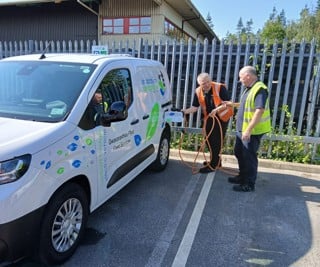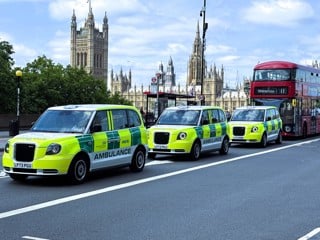A number of large public sector organisations have merged to achieve greater fleet efficiencies through economies of scale.

As the pressure on the public purse continues to bite, Government bodies and local authorities are looking to merge to save money and resources.
 Environment Agency, which sits under the Department for Environment, Food and Rural Affairs (Defra), is taking the fleet lead as part of a wider shared service programme across the department.
Environment Agency, which sits under the Department for Environment, Food and Rural Affairs (Defra), is taking the fleet lead as part of a wider shared service programme across the department.
Environment Agency head of fleet services Dale Eynon has become head of Defra group fleet services and is responsible for vehicles and plant in the new programme, which began in early April.
“Every Defra body doesn’t need its own fleet department,” he says. “We had the biggest number of people and largest asset base, so it was the logical choice.”
Integrating vehicles from other bodies within Defra wasn’t the first shared service deal for Eynon, as the Environment Agency had previously been working with the Rural Payments Agency to manage 200 vehicles.
Under the new structure, there is no mandate for Defra bodies to use the new group fleet services department – instead, Eynon has to sell the benefits.
“There’s a presumption of cooperation, but we will show the cost benefits,” he says.
The new group fleet services team is welcoming staff from other organisations, as well as looking at how to transfer services from incumbent providers.
“In some cases there is potential for TUPE transfer, and in other cases it is about reviewing existing service agreements, and investigating how to transfer those into our operation,” says Eynon. “In a way, we’re running an internal hire service that people will use to obtain all their fleet services.”
One challenge for Eynon is funding. At present, the team is not funded centrally so the new ‘customers’ for fleet will have to pay a proportional contribution to use the group fleet services department.
“It’s always difficult to ask for money, but a small contribution gets you big savings,” he says. “Even with that contribution, the benefits they’ll gain much, much outweigh that – and we can back that up with evidence.”
The benefits aren’t just limited to the organisations sharing Environment Agency’s services – the agency itself is likely to benefit.
“We become a bit bigger and more attractive to our partners,” says Eynon. “We can probably get marginally better value. In addition, we want to develop environmental and health and safety benefits across the fleets.”
In its first year, the fleet services team has a savings target of £500,000.
“We think we’ll be able to see more savings in the future – looking at areas like demand management, grey fleet, and mobility solutions,” adds Eynon.
Government agencies Countryside Council for Wales, the Forestry Commission and the Environment Agency merged their Welsh operations in April 2013, under the new Natural Resources Wales (NRW) body.
Bruce Cochrane, mechanical engineer and fleet manager at Natural Resources Wales, explains some of the challenges they faced.
“We had to take three very differently operated fleets and come up with a model that would effectively serve the new body,” he says.
“We had three different fleet management systems, vehicles outsourced with partner companies as well as in-house workshops and facilities.”
After the bodies merged, the fleet team had to bring together all operations under a new set of policies.
“We had legacy documents for each organisation, and needed to adapt them to create the best fit for the needs of NRW,” says Cochrane.
A travel decision tree helped the newly-formed organisation bring about a drastic change to its car fleet.
Cochrane explains: “Staff use a travel decision tree to make an informed decision on the best method to get somewhere on a journey-by-journey basis.
“We invested in Skype systems, and encouraged staff to use public transport where possible.
We wanted to challenge the way our staff drive. Moving away from an employee car scheme was hard, but now we have 400 fewer vehicles on fleet, and people are still able to do their jobs.”
The fleet savings programme is expected to save £900,000, but Cochrane says this saving has to be earned. “People have to put the effort in to make it work – we can’t just keep doing it the old way.”
Tony Chalk, head of fleet at Police Scotland, managed one of the largest public sector mergers in recent years, integrating fleet departments in 10 police authorities across the country three years ago.
The merger brought about centralised management of 3,600 vehicles and 149 staff, now down to 3,450 and 109 respectively.
The key benefit for Chalk was the ability to centrally purchase a standard specification of vehicle.
“We had several different fleets all buying different makes, models and specifications of vehicles that could be streamlined,” he says.
The latest vehicle purchase agreement, as part of the Northern Police fleet buying group (see box out) is expected to save Police Scotland in the region of £500,000 over two years.
New technology systems brought greater visibility of the fleet, and a structure of three area managers was introduced to monitor workshops and vehicles.
Chalk confesses that the varying pace of change within the organisation was one of the most difficult factors of the merger.
“All teams were going through the same pain, but it was occasionally frustrating when another team, such as HR or facilities, were not at the same point in the process,” he says. “In a fleet department merger, they would be there to support you more.”
He advises others likely to be in a similar position to look for guidance and best practice outside their own sector.
“Don’t just look internally at how you do things,” he adds. “Look at other organisations, including the private sector, and see how things could be done differently.
“Don’t get too focused on ‘the way it’s always been done’. A merger is the ideal time to look at your fleet and make sure your processes and policies will still work in five years’ time.”
Making savings by working together: how other fleets handle mergers
Several public sector organisations have seen savings by working together on projects or buying groups in addition to the Crown Commercial Service frameworks.
While the forces themselves may be separate entities, 28 bluelight fleets have come together to form their own buying consortium.
Arranged by West Midlands Police, the southern deal saw forces from Cornwall to Northumbria club together to take advantage of standard, unified specifications and make savings. More than 2,000 vehicles will be delivered over the two years of the contract. A similar deal has been arranged for forces in the north of England and Scotland.
John Gorton, head of transport at Kent and Essex Police, says: “The move towards vehicle buying frameworks means we are operating with the efficiencies of a 44,000-vehicle fleet. The more efficiencies we can drive, the more we can save.”
In Scotland, unlike the police, healthcare provision is not currently operated by a single authority, but fleet support services are merging. The new National Fleet Support Unit provides operational assistance to the country’s 22 health boards.
Michael Jackson, who is leading the new body, says: “NHS Scotland requires a fleet structure that is flexible and resilient and has an appropriate skills mix in order to maximise service improvement, efficiencies, and ensure the operation is responsive to its future needs.
“Investment in the establishment of a National Fleet Support Unit, together with the procurement of fleet systems, will ensure that agreed management and engineering duties, currently undertaken many times at NHS Board level, are carried out once nationally and consistently for NHS Scotland.”


















Login to comment
Comments
No comments have been made yet.